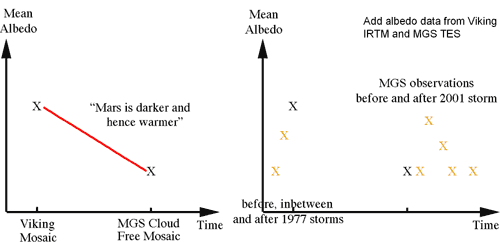 Arguments
Arguments
 Software
Software
 Resources
Comments
Resources
Comments
 The Consensus Project
The Consensus Project
 Translations
Translations
 About
Support
About
Support


Latest Posts
- Skeptical Science New Research for Week #51 2025
- What are the causes of recent record-high global temperatures?
- Fact brief - Are toxic heavy metals from solar panels posing a threat to human health?
- Emergence vs Detection & Attribution
- 2025 SkS Weekly Climate Change & Global Warming News Roundup #50
- Skeptical Science New Research for Week #50 2025
- The rest of the world is lapping the U.S. in the EV race
- Fact brief - Are electromagnetic fields from solar farms harmful to human health?
- Comparing climate models with observations
- 2025 SkS Weekly Climate Change & Global Warming News Roundup #49
- Skeptical Science New Research for Week #49 2025
- Climate Adam & Dr Gilbz - Paris Climate Agreement At 10: Did It Do Anything?
- Fact brief - Does the recent slowdown in Arctic sea-ice extent loss disprove human-caused warming?
- Why the chemtrail conspiracy theory lingers and grows – and why Tucker Carlson is talking about it
- 2025 SkS Weekly Climate Change & Global Warming News Roundup #48
- Skeptical Science New Research for Week #48 2025
- Consensus machines
- Just have a Think - How an African energy revolution could save ALL of us.
- A girl’s grades drop every summer. There’s an alarming explanation.
- 2025 SkS Weekly Climate Change & Global Warming News Roundup #47
- Fact brief - Are changes in solar activity causing climate change?
- Skeptical Science New Research for Week #47 2025
- Exploring newly released estimates of current policy warming
- Climate Adam - Why the Climate Crisis is a Health Crisis
- Super pollutants are trendy, but we should be careful how we use them
- 2025 SkS Weekly Climate Change & Global Warming News Roundup #46
- Skeptical Science New Research for Week #46 2025
- On the Gates climate memo
- Climate Adam - Climate Scientist responds to Bill Gates
- Five ways Joe Rogan misleads listeners about climate change
Archived Rebuttal
This is the archived Intermediate rebuttal to the climate myth "Mars is warming". Click here to view the latest rebuttal.
What the science says...
| Martian climate is primarily driven by dust and albedo and there is little empirical evidence that Mars is showing long term warming. |
The primary empirical evidence for long term, global warming on Mars comes from Fenton 2007. Fenton compared a composite snapshot of Mars from 1977 taken by the Viking spacecraft to a 1999 image compiled by the Mars Global Surveyor (referencing work from Geissler 2005). The 1977 snapshot showed a brighter planet. In 1999, the planet had a lower albedo, with prominent darker regions in the southern mid and high latitudes. Using the albedo changes in a general circulation model, Fenton calculated a 22 year global warming trend of 0.65°C.

Figure 1: Snapshots of Mars 1977 (top) and 1999 (bottom). Image courtesy of Geissler 2005.
Fenton attributed the warming to surface dust causing a change in the planet's albedo. Martian dust plays a major role in the planet's climate (Kahn 1992). Solar variations are not the main driver of Martian climate. Nevertheless, an important question remains: is the interpretation of long term global warming on Mars correct?
A broader view of Martian climate change
To put these results in proper perspective, an understanding of what drives Martian climate is required. Global dust storms increase the surface albedo by settling brighter dust on dark surfaces. Within a year after a dust storm, various wind systems remove the dust and Mars returns to a normal, lower albedo.
The 1977 snapshot was taken after a global dust storm had deposited dust over the southern latitudes, lightening the planet surface. Before the storm, the planet had albedo comparable to recent measurements (Szwast 2006).
Fenton drew conclusions about long term climate by comparing two end points. This led to the classic error of mistaking weather for climate (similar to the recent global cooling argument). When you look at the broader data, there is no discernable long term trend in albedo:

Figure 2: Comparison of data sampling by Fenton 2007 (left, comparing 2 end points) and the full sample of data (courtesy Mark Richardson).
The apparent long-term warming between the 1970's and 1990's is largely a consequence of the timing of the two snapshots used. The "brighter" 1977 snapshot was immediately after a global dust storm when the planet was temporarily lighter. The "darker" 1999 snapshot was of the planet in it's usual state. There is little evidence that Mars is undergoing decadal-scale, long term global warming. In fact, following the 2001 global dust storm, the southern hemisphere was brighter than in 1977 (Szwast 2006).
Conclusion
The empirical evidence isn't conclusive on whether global warming is happening on Mars. However, to answer the question on whether the sun is causing Earth's global warming, there is plentiful data on solar activity and Earth's climate. Many papers have examined this data, concluding the correlation between sun and climate ended in the 70's when the modern global warming trend began.
So the argument that Martian warming disproves anthropogenic global warming fails on two points - there is little empirical evidence that Mars is warming and Mars' climate is primarily driven by dust and albedo, not solar variations.
Updated on 2010-08-20 by John Cook.
THE ESCALATOR

(free to republish)
























































